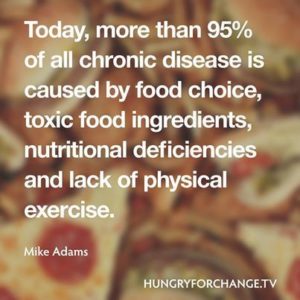
I am posting this newsletter from David Allen in its entirety as it contains great data for you
Balancing your hormones naturally and learning how to protect thyroid health, is critical to every function inside you and how you feel day by day.
Unfortunately, your body is blasted regularly with compounds that mimic the hormones your body produces, overwhelming your system. Your diet and lifestyle habits can deplete your hormones, leaving you deficient. When your hormone levels are too high or too low, it can make you feel like a stranger in your own skin. Hormone balance is vital to overall health.
The Thyroid Dysfunction Epidemic (No One Knows About)
In the United States alone, more than 20 million people suffer from a thyroid disorder and the American Thyroid Association estimates that 12% of the population will struggle with thyroid issues within their lifetime.
It’s an epidemic and many remain undiagnosed, unaware that their thyroid is in danger. The primary reason for this is that many patients (as well as their doctors) mistake the common symptoms of thyroid dysfunction for something else entirely.
10 Major Signs You Need to Take Steps to Protect Your Thyroid
Low energy: persistent exhaustion no matter how much sleep you get
Poor sleep quality: being unable to sleep or wanting to sleep all the time
Mood swings: feelings of sadness or anxiety
Changes to appetite: including changes to food preferences or altered taste
Brain fog: inability to concentrate or difficulty with simple cognition
Bowel irregularity: bloating, gas, constipation, or diarrhea
Temperature sensitivity: you persistently feel too hot or too cold
Chronic pain: aches in joints or muscles for no discernible reason
Reproductive issues: infertility, miscarriages, or premature births
Menstrual changes: increase or decrease in cramps, flow, or length of periods
The Role of Your Thyroid
There are two hormones [thyroxine (T-4) and triiodothyronine (T-3)] produced by your thyroid gland – a butterfly shaped gland in your lower throat. These are responsible for managing your metabolism, body temperature, and blood pressure.
Though this part of the endocrine system is small, it is mighty. It literally effects every organ and function inside you because every cell utilizes thyroid hormones.
When this gland malfunctions, it can cause all sorts of chaos. There are three primary forms of thyroid dysfunction that you need to watch for (and guard against).
Hyperthyroidism (less common) is when your thyroid produces too many hormones. It is also referred to as an overactive thyroid. This condition can result in unexplained weight loss, feeling jittery or anxious, an inability to relax, lack of focus, rapid heart rate, fatigue, marked increase to appetite, deterioration of nails, skin, and hair, heart disease, irritability, sleep irregularity, and intolerance to heat.
Hypothyroidism (most common) is the term used when your thyroid produces too few hormones. It is also referred to as an underactive or sluggish thyroid. You may notice no symptoms initially, but they tend to appear and worsen as time goes by. Deficiency in essential hormones lead to feelings of fatigue, depression, obesity, pain in joints, muscle weakness, deterioration of hair, skin, and nails, heart disease, poor memory and focus, and intolerance to cold.
Hashimoto’s Disease is an autoimmune condition. Your immune system malfunctions and sends out antibodies to attack thyroid tissue. Over time, the thyroid is beaten down and unable to function properly. The majority of patients with hypothyroidism test positive for these antibodies. It is important to keep your immune system strong and lower body-wide inflammation to prevent these antibodies from destroying your thyroid.5
Your thyroid is stimulated by signals from your brain’s hypothalamus and your pituitary gland tells the thyroid gland to either produce hormones or to hold back. When the signals are blocked or incorrect, it can result in serious repercussions throughout your system.
Common Triggers of Thyroid Malfunction
Nutritional deficiency (particularly iodine)
Autoimmune disease that stimulates hormone production (Grave’s)
Benign lumps that stimulate thyroid hormone production (Plummer’s)
Pregnancy
Inflammation that triggers excess hormones to flood the blood (thyroiditis)
Physical, mental, or emotional stress
Environmental toxins
No matter your age, it is critical to protect your thyroid function. Problems can develop in adults, children, and even infants. Newborns tested and treated early respond well and the safeguard may prevent poor mental development.
There are synthetic hormones available through the pharmaceutical companies. In fact, thyroid medications are the fourth highest selling drugs in the United States. They may help to get your thyroid back on track. However, patients must possess a thyroid that no longer functions for the synthetic replacements to work.
Preventing the destruction of your thyroid in the first place is a far better solution. There are steps you can take to protect your thyroid naturally through diet and lifestyle.
5 Best Foods for Your Thyroid
Seaweed and seafood (scallops, shrimp, sardines, salmon, and tuna)
Yogurt, eggs, and cheese
Coconut oil
Cranberries and cranberry juice
Baked potatoes (with skin)
5 Worst Foods for Thyroid Health
Soy products
Refined gluten grains
Sodas, alcohol, or excessive coffee
Hydrogenated oils (avoid processed or fast foods)
Refined sugar
Using Vitamin C to Balance Hormones
Increased consumption of foods rich in vitamin C has been proven to fight cancer and improve overall health. When molecules become unstable due to damage or mutation, vitamin C is considered a “universal donor” – able to contribute molecules to reestablish molecule stability.
In one study conducted published in Radiation Physics and Chemistry journal, researchers found that vitamin C stimulated almost 100% regeneration of estrone (estrogen), more than 50% of progesterone, and almost 60% of testosterone.
Researchers are hopeful that this will lead to an alternative treatment to hormone replacement therapy (synthetic hormones that increase cancer risk after just a few years of use). HRTs are also implicated in a higher risk of stroke and sudden death.
However, vitamin C can be taken at high doses safely and is beneficial in many ways to overall human health, including strengthened immunity, preserved vision, anti-aging, and protection against heart disease.
Don’t Ignore Your Thyroid
Strange symptoms you can’t explain may be due to hormone imbalance. Talk to your doctor about testing. If your hormone levels are off, even if you’re given a prescription, there are natural ways to bring them back in balance.
Currently, there is no cure for autoimmune diseases such as Hashimoto’s that cause extensive damage to the thyroid and result in additional health conditions such as hypothyroidism. As with most autoimmune disorders, it’s crucial to pay close attention to diet and lifestyle habits. It may not reverse thyroid damage, but it will slow deterioration and ease symptoms.
Each of your internal systems are connected. They depend on each other to function properly. Therefore, if you eat right for your thyroid, it’s going to be good for your brain, heart, gut, and so on. Making good diet and lifestyle choices to protect your thyroid is good for your entire body.
To Your Health & Longevity,
David Allen
President,
Medical Research Associates
Breakthroughs in Health & Medicine
https://realmedicalhelp.com/newsletter/2018/04.28.18-InHouse-MRA-News.html
Take Control Of Your Future Health
More Mental Clarity and Lasting Physical Energy

Thank you for your feedback! It means the world to me. This week a consumer of my Mother’s Blend was kind enough to tell me:
I just want to say thank you for producing such an amazing product. My overall wellbeing has been amazing and this mothers blend is amazing.
Seriously, if you know any girl who is pregnant or is considering getting pregnant, or breast feeding, let them know about it. The reports of benefits on my Mother’s blend are almost universally great! Here’s the link: http://www.healthelicious.com.au/Nutri-Blast-Mothers-Blend.…
And a chap who tried my low FODMAPs bar (for people with sensitive digestive systems) sent me this:
I received my package… …Monday and have tried the low fodmaps bars. They taste pretty good and even though I barely slept Monday night, not sure why, 30 mins after eating the bar Tuesday morning I was full of energy and my mental clarity was pretty awesome.
These seem to be the two most commonly reported differences people notice from my bars and powders, full of physical energy and awesome mental clarity.
So if you are not regularly consuming my bars or powder and are not feeling like that, give it a try! What have you got to lose but lack of energy and mental fog?
http://www.healthelicious.com.au
Big Pharma Wants People on Antidepressants for Years and It’s Working
by Martha Rosenberg April 27, 2018
Antidepressants were once considered a short-term therapy to help people get over a troubled time. All that changed with the debut of selective serotonin reuptake inhibitor (SSRI) antidepressants, drug ads on TV and the promotion of the “chemical imbalance” theory of depression. Though there is almost no evidence of the theory––that SSRI antidepressants correct deficits in brain levels of serotonin, a neurotransmitter––antidepressants became block busters for Pharma. “By the mid-1990s, drug makers had convinced government regulators that when taken long-term, the medications sharply reduced the risk of relapse in people with chronic, recurrent depression,” says the New York Times.
Thanks to drug advertising and the unproven serotonin theory, the use of antidepressants has almost tripled. Only 13.4 million Americans took antidepressants in 1999-2000 ballooning to 34.4 million in 2013-4. In 2015 one in four U.S. women were on psychiatric drugs, usually antidepressants. More concerning, long-term use of antidepressants has doubled since 2010 and tripled since 2000 so that 15.5 million Americans have been taking the medications for at least five years. Yet few studies show the safety or efficacy antidepressants used long-term.
I have frequently reported on the side effects of SSRIs from birth defects associated with Paxil including heart malformations to sexual dysfunction and weight gain. The pills are also linked to serotonin syndrome when taken with migraine drugs and gastrointestinal bleeding when taken with aspirin.
One especially concerning side effect of SSRIs is bone-thinning and osteoporosis. Fracture events linked to SSRIs, especially from long-term use, have barely been researched or explored and are often dismissed by older patients as mere “aging.”
The wide use of SSRIs in the U.S. population does not just have health implications–it has political implications, too. By selling “depression” and its “cure” Pharma siphons off legitimate, activist anger at a government system that keeps people poor, powerless, locked out of opportunity and saddled with debt. If they are unhappy, they have a personal problem says Pharma, treated with a pill––not a political problem.
Labeling bad and sad moods “depression” also transmits an unrealistic idea that people should be “more than happy” all the time and if they are not, they are “mentally ill.” Gone are the days when bad moods were attributed to problems with finance, romance, debt, jobs, housing, careers, family, marriages and health.
Pharma Backlash
In April, the New York Times reported something the drug safety community has warned about for years: antidepressants can be very difficult to quit. In fact, the withdrawal from them––which Pharma calls a “discontinuation syndrome”––is similar to that of addictive drugs. Many patients are miffed that they were not warmed by their doctors they may be “parked” on the drugs indefinitely said the Times thanks to side effects of dizziness, nausea, headache and brain zaps which do not go away quickly when they try to stop the drugs. Brian, a 29-year-old Chicagoan I interviewed who did not want his name used, told me he has remained on a SSRI antidepressant for years despite his wish to quit. “Every time I try to stop, I get something that feels like an electrical current in my head and I can’t do it,” he says.
The article drew a huge backlash from psychiatrics from Pharma-funded medical schools. “By amplifying the social media echo chamber, the article creates the unfortunate impression that most patients are forced to continue antidepressants out of fear of withdrawal rather than out of prevention of recurrence,” wrote 39 psychiatrists, terming depression “chronic” and “undertreated.”
At least 35 of the letter signers who want to see more not less SSRIs are affiliated with Columbia University’s College of Physicians and Surgeons which received $250 million from former Merck CEO Roy Vagelos and his wife Diana last year.
There was a similar Pharma-funded backlash in 2004 when the FDA added a black box warning label to SSRIs that said they are linked to suicide, especially in young people, threatening drug sales.
“The concerns about antidepressant use in children and adolescents have paradoxically resulted in a reduction in their use, and this has contributed to increased suicide rates,” said Charles Nemeroff who happened to have links to Eli Lilly, Pfizer, Wyeth-Ayerst, Pharmacia-Upjohn and five other drug makers. Black box warnings create a barrier to treatment “by scaring young people and parents away from care,” said Mental Health America, reported to have accepted $3.8 million from pharmaceutical companies in 2005 the year after the black box warnings.
Doctors promoting SSRIs in medical articles have also been outed as taking money from Pharma. Doctor authors who had defended the use of antidepressants during pregnancy in a 2006 Journal of the American Medical Association (JAMA) article had ties to antidepressant manufacturers. Lee Cohen, lead author of the antidepressants study, declared in a followup letter to JAMA that, “We did not view those associations as relevant to this study,” and listed 76 other relationships the nine physician authors had with Pharma. Yes, 76. Three years later another JAMA author was found to have undisclosed financial links to SSRI makers. Robert Robinson, who wrote about the drug Lexapro, had failed to report lecture fees he received from its manufacturer.
Martin Keller, former professor emeritus of psychiatry at Brown and lead author of a now discredited Paxil study, admitted that GSK had given him tens of thousands of dollars during and after the study.
Environmental concerns
Finally, with as much as a quarter of the population on SSRIs in some areas, there is an underreported concern about drugs in waterways and even drinking systems. A few years ago, the Southern Daily Echo News reported that fish were under the influence of Prozac and five times more likely to swim toward light than away from it, making them also more susceptible to predators.
Shrimp are also believed to be at risk. ”Crustaceans are crucial to the food chain and if shrimps’ natural behaviour is being changed because of antidepressant levels in the sea this could seriously upset the natural balance of the ecosystem,” says Dr. Alex Ford, from the University of Portsmouth’s Institute of Marine Sciences.
Could those of us who do not want to take psychiatric drugs be unwittingly receiving SSRIs anyway, perhaps in drinking water? “There’s no doubt about it, pharmaceuticals are being detected in the environment and there is genuine concern that these compounds, in the small concentrations that they’re at, could be causing impacts to human health or to aquatic organisms,” said Mary Buzby, director of environmental technology for Merck. Clearly, Pharma’s SSRI marketing spree which has millions of people on SSRIs for decades does not just threaten patients.
Martha Rosenberg is an investigative health reporter. She is the author of Born With A Junk Food Deficiency: How Flaks, Quacks and Hacks Pimp The Public Health (Prometheus).
https://www.counterpunch.org/2018/04/27/big-pharma-wants-people-on-antidepressants-for-years-and-its-working/
Character
Families of the 9/11 victims have filed a petition for a new investigation citing ‘conclusive evidence’ of explosives

This month, the Lawyers’ Committee for 9-11 Inquiry, a group representing families of the 9/11 victims, filed a petition with the U. S. Attorney for the Southern District of New York to push for an investigation into the crimes of 9/11. The committee states that they have “conclusive” evidence that explosives were planted and detonated in the trade center buildings, and that this is the actual reason for the collapse of the towers.
According to the 52-page petition, which is accompanied by 57 exhibits, federal statute requires the U.S. Department of Justice to review the evidence with a special grand jury. The petition states:
“The Lawyers’ Committee has reviewed the relevant available evidence . . . and has reached a consensus that there is not just substantial or persuasive evidence of yet-to-be-prosecuted crimes related to the use of pre-planted explosives and/or incendiaries . . . on 9/11, but there is actually conclusive evidence that such federal crimes were committed.”
The evidence that is put forward in the petition includes the following:
Independent scientific laboratory analysis of WTC dust samples showing the presence of high-tech explosives and/or incendiaries in the form of thermite or thermate.
Expert analysis of seismic evidence that explosions occurred at the WTC towers on 9/11 prior to the airplane impacts on the WTC Towers, and prior to the building collapses.
Technical analysis of video evidence of the WTC building collapses.
Firefighter reports of explosions, and of seeing “molten iron like in a foundry.” The petition states that the presence of molten iron would require temperatures higher than jet fuel and building contents could create when burned, but consistent with the use of the high tech explosive and incendiary thermite or thermate.
The presence of previously molten iron microspheres, which have been established by electron microscope analysis of WTC dust samples, by both government and independent scientists, is another phenomenon that would be scientifically impossible based on the burning of jet fuel and office contents alone.
Video and eyewitness testimony of the ejection during the collapse of WTC 1 and 2 of heavy steel elements laterally from the buildings which would not be possible from a gravity collapse.
Scientific analysis, eyewitness testimony, and government reports confirming sulfidation and high-temperature corrosion of the steel found in the rubble after the collapse of the WTC towers and WTC 7, a phenomenon not expected in a jet fuel fire and gravity collapse but consistent with the use of thermate and high explosives.
After the petition was delivered, the Lawyers committee delivered a press conference outside of the New York District Court, along with families of the victims.
Footage from the press conference can be seen on the site linked to below.
None of the evidence put forward in the petition was presented or considered in the “9/11 commission,” which was initially appointed to investigate the collapse of the towers. In the years since the attacks, the commission has been exposed as a fraud, with many of its own members speaking out against the official story.
According to a 2006 report from the Washington Post, most of the people who oversaw this commission believed they were being lied to, and even held a secret meeting about referring the matter to the Department of Justice.
The report stated that:
“Suspicion of wrongdoing ran so deep that the 10-member commission, in a secret meeting at the end of its tenure in summer 2004, debated referring the matter to the Justice Department for criminal investigation, according to several commission sources. Staff members and some commissioners thought that e-mails and other evidence provided enough probable cause to believe that military and aviation officials violated the law by making false statements to Congress and to the commission, hoping to hide the bungled response to the hijackings, these sources said.”
One of the commissioners who expressed doubts about the evidence was John Farmer, who later wrote a book called “The Ground Truth,” detailing how evidence was intentionally left out of the report and how intelligence agencies lied about important aspects of the incident, including their initial response to the attack.
“I was shocked at how different the truth was from the way it was described …. The tapes told a radically different story from what had been told to us and the public for two years,” Farmer said.
Thomas H. Kean, the former New Jersey governor who led the commission said that NORAD lied about their response to the attack.
“We to this day don’t know why NORAD [the North American Aerospace Command] told us what they told us. It was just so far from the truth. . . . It’s one of those loose ends that never got tied,” Kean said.
The two co-chairs of the Commission, Kean and Lee Hamilton, have said publicly that the commission was “set up to fail.” In their book, Without Precedent: The Inside Story of the 9/11 Commission, Kean and Hamilton describe how the commission was intentionally underfunded and not given ample time to sort out the evidence, and how they were lied to by intelligence agencies and politicians who seemed to have something to hide.
Hamilton said in an interview with the CBC that “We had a lot of skeptics out there, who really did not want the Commission formed. Politicians don’t like somebody looking back to see if they made a mistake.” In the interview, Hamilton also revealed that Henry Kissinger was who they actually wanted to run the commission.
There were even members of the Intelligence Community who had similar stories to tell, including Former FBI Director Louis Freeh who pointed out that there were parts of the report that he knew were false. Specifically, Freeh said that some of the terrorists suspected of carrying out the attack were known about by intelligence agencies for a long time, while the final commission report stated these agencies had no prior knowledge of the terrorists.
The commission was so flimsy that a coalition of intelligence whistleblowers was formed to dispute the official story. The coalition consisted of agents from the NSA, FBI and other agencies, who said that there was evidence that was intentionally ignored and left out of the commission report.
Considering the many problems with the commission, a new investigation is long overdue.
https://nexusnewsfeed.com/article/human-rights/9-11-citing-conclusive-evidence-of-explosives/
No attack, no victims, no chem weapons: Douma witnesses speak

Witnesses of the alleged chemical attack in Douma, including 11-year-old Hassan Diab and hospital staff, told reporters at The Hague that the White Helmets video used as a pretext for a US-led strike on Syria was, in fact, staged. “There were people unknown to us who were filming the emergency care, they were filming the chaos taking place inside, and were filming people being doused with water. The instruments they used to douse them with water were originally used to clean the floors actually,” Ahmad Kashoi, an administrator of the emergency ward, recalled. “That happened for about an hour, we provided help to them and sent them home. No one has died. No one suffered from chemical exposure.”
https://nexusnewsfeed.com/article/geopolitics/no-attack-no-victims-no-chem-weapons-douma-witnesses-speak/
Chemotherapy actually increases cancer growth, cancer cells becoming resistant to treatment: study

Holistic doctors have said for years that chemo kills. Now the evidence is becoming stronger and stronger that they were right!
The cancer treatment scam that is chemotherapy has once again been shown in the scientific literature to be a major cause of, rather than a cure for, cancer. According to a new study recently published in the peer-reviewed journal Nature, chemotherapy not only promotes the growth and spread of cancer cells by damaging the healthy tissue that surrounds tumors, but it also causes cancer cells to develop full-on resistance to the popular treatment, morphing them into “super” cancer cells.
Researchers from the Fred Hutchison Cancer Research Center in Seattle, Washington, learned this after observing the effects of chemotherapy on healthy cell tissue. What they found is something that we here at NaturalNews have been saying for years, but that the medical system as a whole is only just now waking up to — chemotherapy, which is a recognized poison, damages the DNA of healthy, non-cancerous cells, causing them to produce molecules that in turn produce more cancer cells.
https://nexusnewsfeed.com/article/geopolitics/chemotherapy-actually-increases-cancer-growth-cancer-cells-becoming-resistant-to-treatment-study/
The Meal of Death?

This is a very technical article in places but makes some excellent points about dietary research and is a great example of why I am such a fan of Jon Barron!
https://jonbarron.org/heart-health/meal-death
Richard Moskowitz, M. D. – The Case Against Immunizations

For the past ten years or so, I have felt a deep and growing compunction against giving routine vaccinations to children. It began with the fundamental belief that people have the right to make that choice for themselves.
https://vaccineimpact.com/2015/richard-moskowitz-m-d-the-case-against-immunizations/


